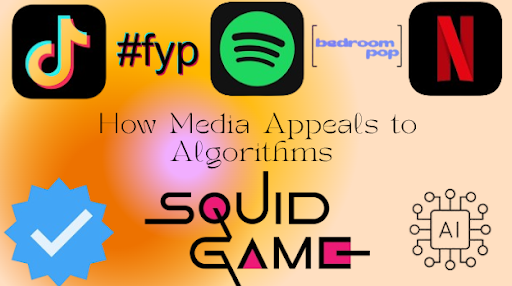For many years, DJs, radio hosts, film connoisseurs, and the general public decided what was popular in the media. Now, what’s popular is often decided by AI algorithms run by tech giants. On any typical day in 2010, a person could say that their favorite song is a Kesha song played frequently on the radio, but now they could say that their favorite song is a viral TikTok song. As popular media continues to evolve, it is becoming more clear that pop culture is no longer shaped by people, but by algorithms behind the scenes.
Each streaming platform has a unique way of determining what content goes mainstream and what content gets left behind. “I think that they give you more of that content once you show interest in something. Websites tailor themselves to what will grab your attention the most, so you spend the most time with that type of content. That increases views and grabs your attention further,” said Jacob Kriwox, sophomore.
Netflix recommends shows and movies to viewers based on their watch history. Spotify gives listeners a discovery playlist weekly based on their commonly listened to artists, genres, and songs, and TikTok’s “For You Page” is based on your liked videos and creators you follow.
Over the last few years, these platforms have launched singers, actors, and content creators into fame. Spotify has been credited with the rise of indie music and bedroom pop, Netflix has had surprising hits like Squid Game and Beef, and TikTok has launched many different content creators, books, and songs into popularity and fame. How algorithms push content shapes what we view and how creators create it because of the new standards, the goal to go viral, and popularity in general.
Lately, consumers are seeing artists and creators put out very engineered content to fit the new standard for content. This new standard emphasizes inclusivity, audience engagement, flashy clothes and accessories, and adding in certain elements to make the video more engaging. “I think people alter the stuff they put out to try and get popular because it makes it more validating for them. So, they try to appeal to what’s popular and what they’ve seen blow up,” said Olivia DeMacy, freshman.
People have seen songs getting shorter and including a catchy hook within the first ten seconds; this technique is strategic and designed to be TikTok-friendly. Netflix shows now include even catchier cliffhangers and also have a new release policy where half a season of a show gets put out, then the viewers have to wait for the last few episodes, increasing watch time and views on any given show on their platform.
Content creators tailor thumbnails, captions, and editing styles to suit trends, as well as clickbait, to trick viewers into watching their posts, maximizing their views, and increasing their popularity. “Influencers try and make themselves as appealing as they can through lifestyle, appearances, and dream traits. They have a whole other personality online, and that’s what we see, and that’s what appeals to us because we want to pick up on their traits and embody that,” said Kriwox.
Because of this, content across all platforms is curated for machines to sort out the popular and unpopular rather than being sorted by human opinions.
While the systems of having an AI algorithm discover niche content and music can be positive and beneficial to consumers, there are also risks posed by this. Suppose someone continues to like the same type of videos, shows, and songs, whic can create a bubble that limits exposure to diverse genres and perspectives. This also means that likes, shares, and views often outweigh the artistic value or meaning of something.
Algorithms aren’t all bad, though; they can also be credited with destroying barriers like location and language. Now more than ever, consumers can see a cultural crossover on TikTok and Spotify, a new hit song could be a Thai pop hit, or there could be a new dance inspired by South African dances, or a Polish meme could be trending. This is improving diversity in what consumers see daily, helping globalize feeds and tastes in the process.
As streaming platforms become more popular and people’s primary source of entertainment, they start to reflect not only our tastes, but they also shape them. Being able to understand the ways of an algorithm, it isn’t just about what goes viral, it is also about being more aware and understanding pop culture and how it is being engineered by our actions on social and streaming platforms.

Leave a Reply